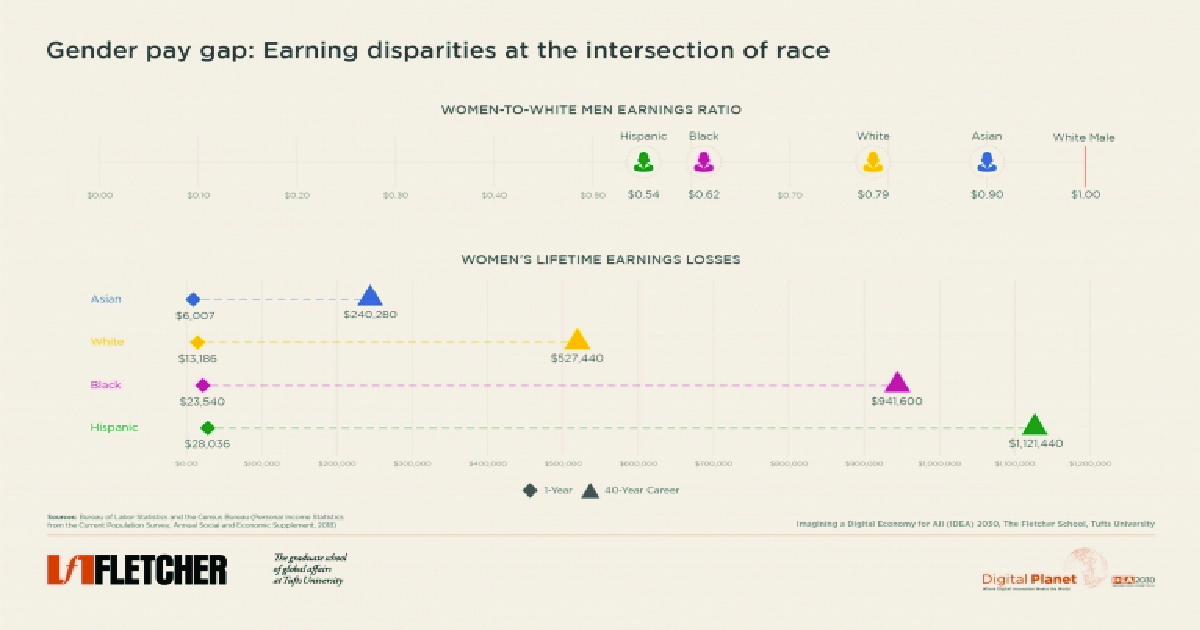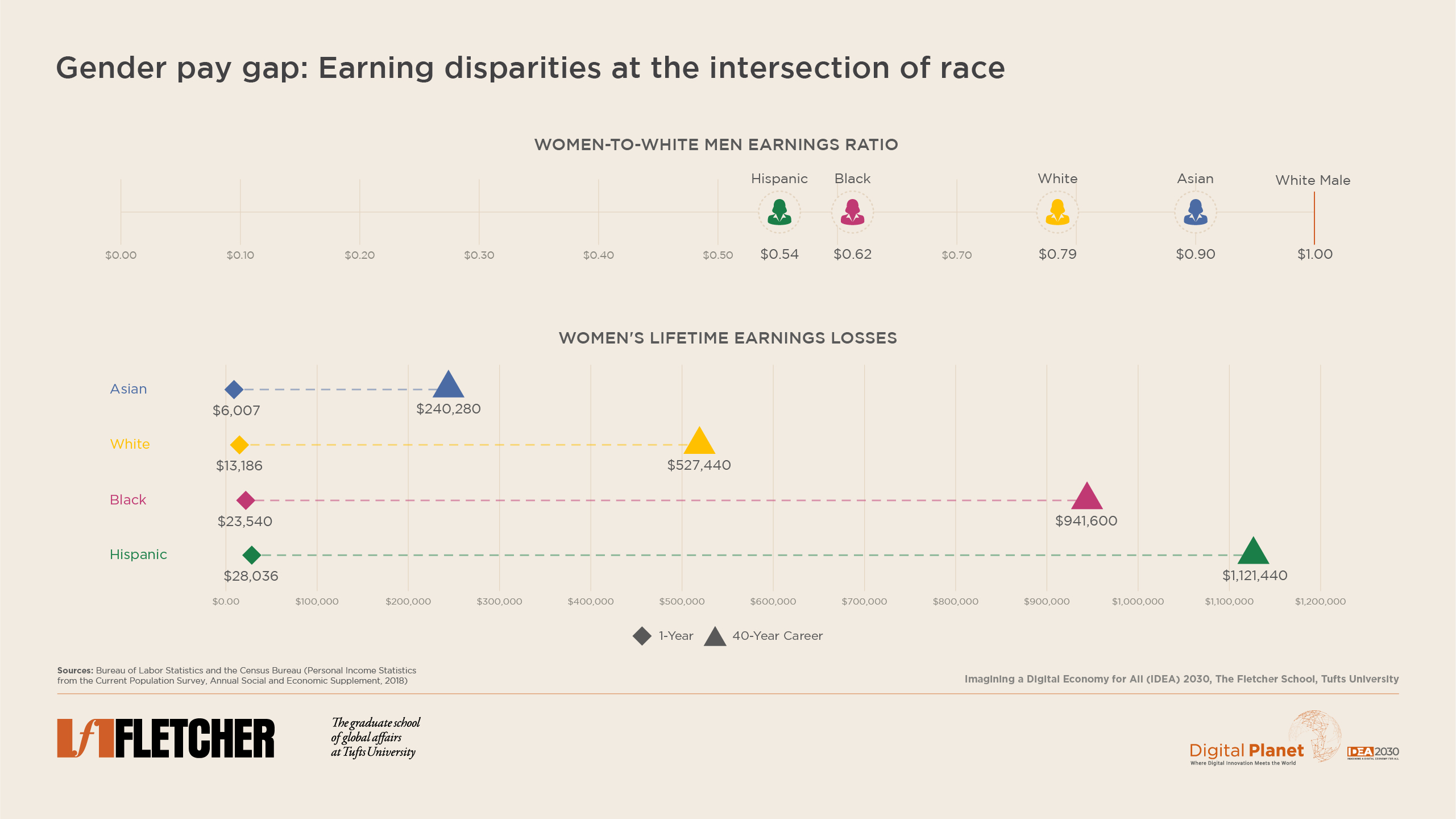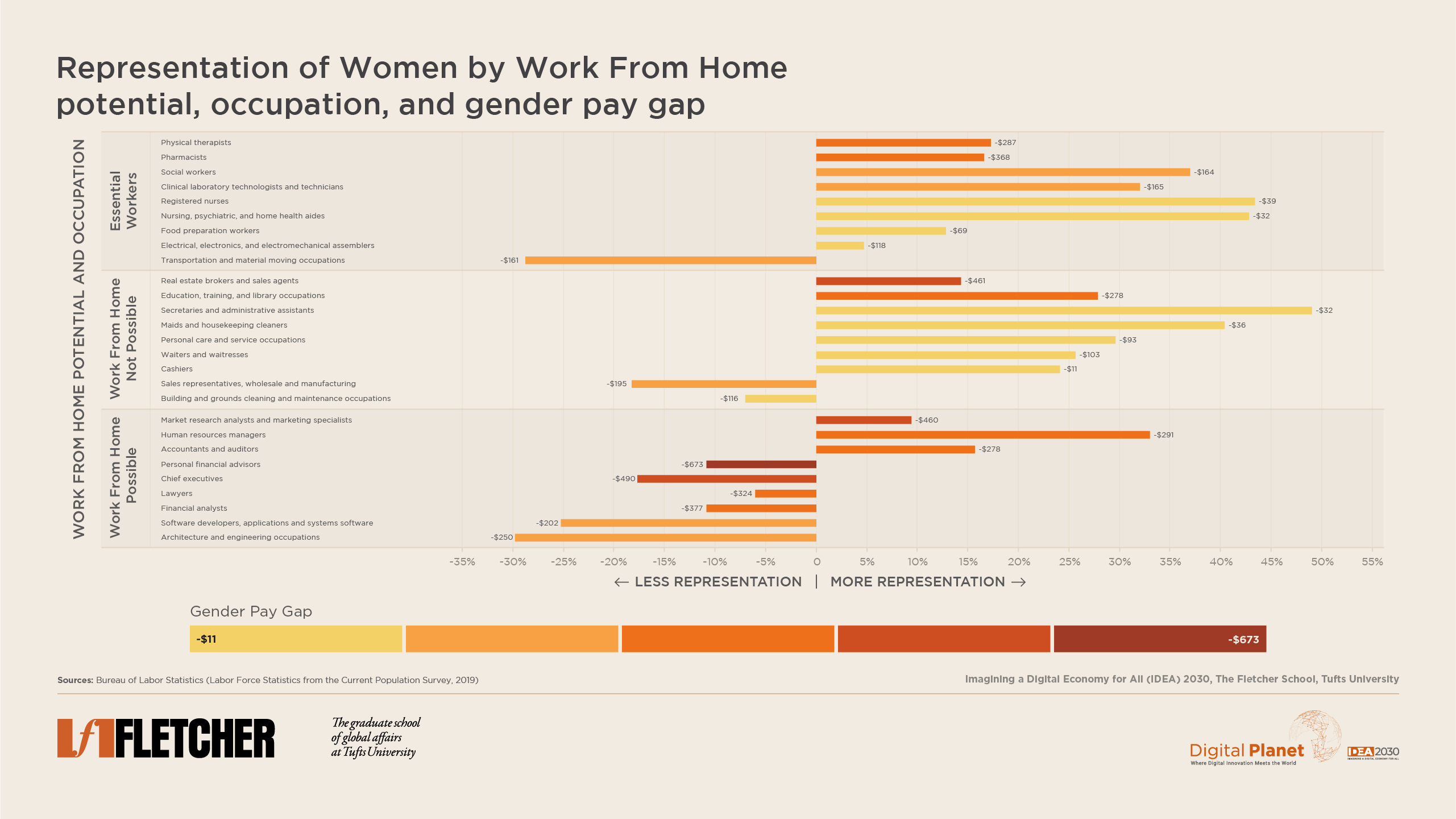Home > Off the Charts > Uneven State of the Union
The State of the Gender Pay Gap:
Earning Disparities Widen as Women Bear the Brunt of the Pandemic
Summary
In the US, women make 82¢ for every man’s $1––a significant disparity that is exacerbated by factors like race and education. As the pandemic rages on, women are bearing the brunt of it on multiple levels: 1) as essential workers on the frontlines; 2) being over-represented in occupations that are not conducive to working from home, and losing jobs crucial to their economic stability; and 3) being under-represented in jobs that could shift to a digital medium, and all this while paying the price of chronic pay gaps and an unequal division of household labor.
Key Observations and Insights
Our Digital Planet research previously analyzed the racial divides of the pandemic and the exacerbation of systemic inequities in access. We now turn our focus to gender and examine COVID-19’s disproportionate impact on women, first noting the pay gap, followed by occupational disparities in workforce representation.
The Earnings Divide at the Intersection of Race and Gender
In 2018, the women-to-white men median annual earnings ratio stood at 82¢ overall. However, layering the structural inequities of race and gender paints a vastly different picture. Black and Hispanic women face the largest wage gap differential when compared to a white male’s $1, making just 62¢ and 54¢, respectively. While Asian women appear closest to bridging the gap, earning 90¢ at the median, the diversity among the community’s sub-groups warrants further scrutiny. For example, Vietnamese American women make 67¢ and Nepalese American women make just 50¢ to a white male’s $1.
Strikingly, reflecting on the gender pay gap in absolute dollars demonstrates the staggering extent to which women of all races lose out on potential income, compared to a white male. Compounding the wage differential over the course of a typical 40-year career, white women earn $527,440 less than their male counterparts, while Black women face losses of $941,600. Hispanic women suffer the biggest deficit of all––an astonishing $1.12 million dollars. Given that men rise through the ranks faster and their incomes grow at higher rates than women, these figures likely underestimate the true earnings gap in a woman’s lifetime.
The Divide Worsens With Education
While higher education leads to greater weekly median earnings, gender pay gap still persists. Perplexingly, women with advanced degrees earn less than men with bachelor’s degrees ($1,372 to $1,473). The divide actually widens with higher degrees––the $372 difference at the bachelor’s level increases to $517 with graduate education––so while more schooling may move women into higher-income jobs, they suffer from greater gender-based income inequality once there.
The Pandemic Disproportionately Hurts Women
Women account for 44.7% of the labor force, but are particularly over-represented in low-tech, high-touch, low-income occupations, such as personal care and services (74.1%), waitresses (70.0%), and maids and housekeeping cleaners (85.9%)––a distinction in part due to gender norms and expectations. On the flip side, they are under-represented in high-tech, high-income jobs, like chief executives (27.1%), software developers (19.5%), and architecture and engineering-related occupations (15%). As of this writing, a mere 7.4% of the Fortune 500 companies are headed by women, according to The Economist, a newspaper.
This imbalance is important not just because workers in high-tech occupations are better able to transition to a work from home environment during a pandemic, but also since it widens the existing gender pay gap.
As COVID-19 shows no sign of abating, women are bearing a disproportionate share of the burden: 1) as essential workers on the frontlines; 2) being over-represented in occupations that are not conducive to working from home, and losing jobs crucial to their economic stability; and 3) being under-represented in jobs that could shift to a digital medium, and all this while paying the price of chronic pay gaps and an unequal division of household labor.
First, women, especially Black and Hispanic women, are over-represented in essential occupations, particularly in healthcare and caregiving––as registered nurses (87.9%) and social workers (81.6%), to name a few. These unseen soldiers have been an indispensable part of fighting the pandemic, but it comes with the added risk of catching the disease. Additionally, as schools and childcare centers closed down, and older relatives became hesitant to step in fearing their own vulnerabilities, essential mothers have been left to navigate 24/7 childcare while they take on additional work shifts.
Second, women are also over-represented in the leisure and hospitality industry––in personal care and services (74.1%) and as waitresses (70%)––occupations that could no longer function during a time of social distancing and stay-at-home orders. From February to May 2020, 11.5 million women lost their jobs (compared to 9 million men)––a 15% drop. These jobs were already in the low-income bracket, so women forced out of employment are likely contending with a smaller financial cushion to fall back on.
Third, amongst occupations that could readily shift to a work from home model, women are under-represented––as lawyers (38%) and financial analysts (33.9%), for example. With the already unequal division of household labor, in lockdown, working mothers are faced with balancing jobs, childcare, and schooling––making crucial decisions that may ultimately hurt their professional careers.
Most notably, women consistently earn less than men across all occupations, and the divide widens with high-income, work from home jobs. Given that these professions are primarily contract-based, the gender pay gap is literally written into, formalized, and enforced, in legal agreements.
COVID-19 has ravaged the country in unprecedented ways; at a household level, the burden has disproportionately fallen on women’s already encumbered shoulders and especially so for Black and Hispanic women.
Considering the pandemic’s economic impact on top of existing structural inequalities is critical, in developing policy responses to provide women with necessary support, and to finally close the gender pay gap.
Research Methodology
Women-to-Men Earnings Ratio
Data on women-to-men earnings ratio is calculated as a proportion of median annual earnings for full-time, year-round workers for women against white men in 2018, broken down by race/ethnicity. Figures are pulled from the Annual Social and Economic Supplement, Current Population Survey as part of a joint effort between the U.S. Census Bureau and Bureau of Labor Statistics.
Earnings Divide by Race
Data on the 1-year earnings divide is calculated as the difference in median annual earnings for full-time, year-round workers between women and white men in 2018, broken down by race/ethnicity. Estimates for the 40-year earnings divide are based on the 1-year earnings divide in 2018, multiplied over a typical 40-year career using constant 2018 dollars. Figures are pulled from the Annual Social and Economic Supplement, Current Population Survey as part of a joint effort between the U.S. Census Bureau and Bureau of Labor Statistics.
Earnings Divide by Level of Education
Data on the earnings divide by level of education plots the median usual weekly earnings for full-time wage and salary workers for men and women in the first quarter of 2020, as published by the Bureau of Labor Statistics.
Occupational Representation of Women by Income Level and Pay Gap
Data on the occupational representation of women and median weekly earnings for men and women is pulled from the Bureau of Labor Statistics and covers the year 2019. Income level for each occupation is broken down into four categories (low, middle-low, middle-high, and high) based on total median weekly earnings in 2019. The pay gap for each occupation is calculated as the difference in median weekly earnings between men and women in 2019.
All data and sources are available here.
Digital Planet student analysts Patrick Béliard, Christopher Duyos, Malavika Krishnan, and Devyani Singh worked on this analysis under the guidance of Bhaskar Chakravorti, Ravi Shankar Chaturvedi, Christina Filipovic, and Joy Zhang at Digital Planet, The Fletcher School, Tufts University.
This research is a part of the IDEA 2030 initiative, made possible by the generous support from the Mastercard Center for Inclusive Growth












